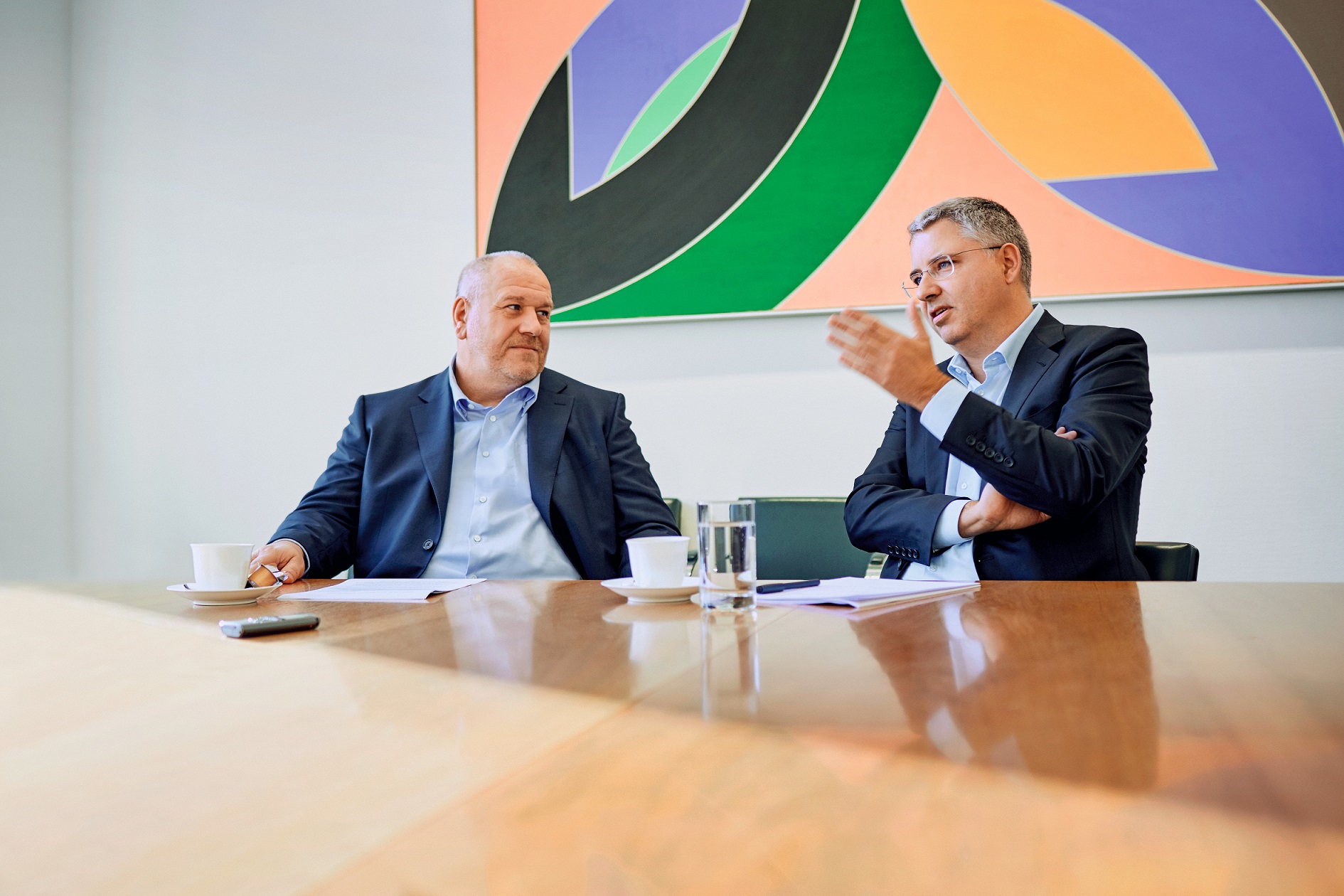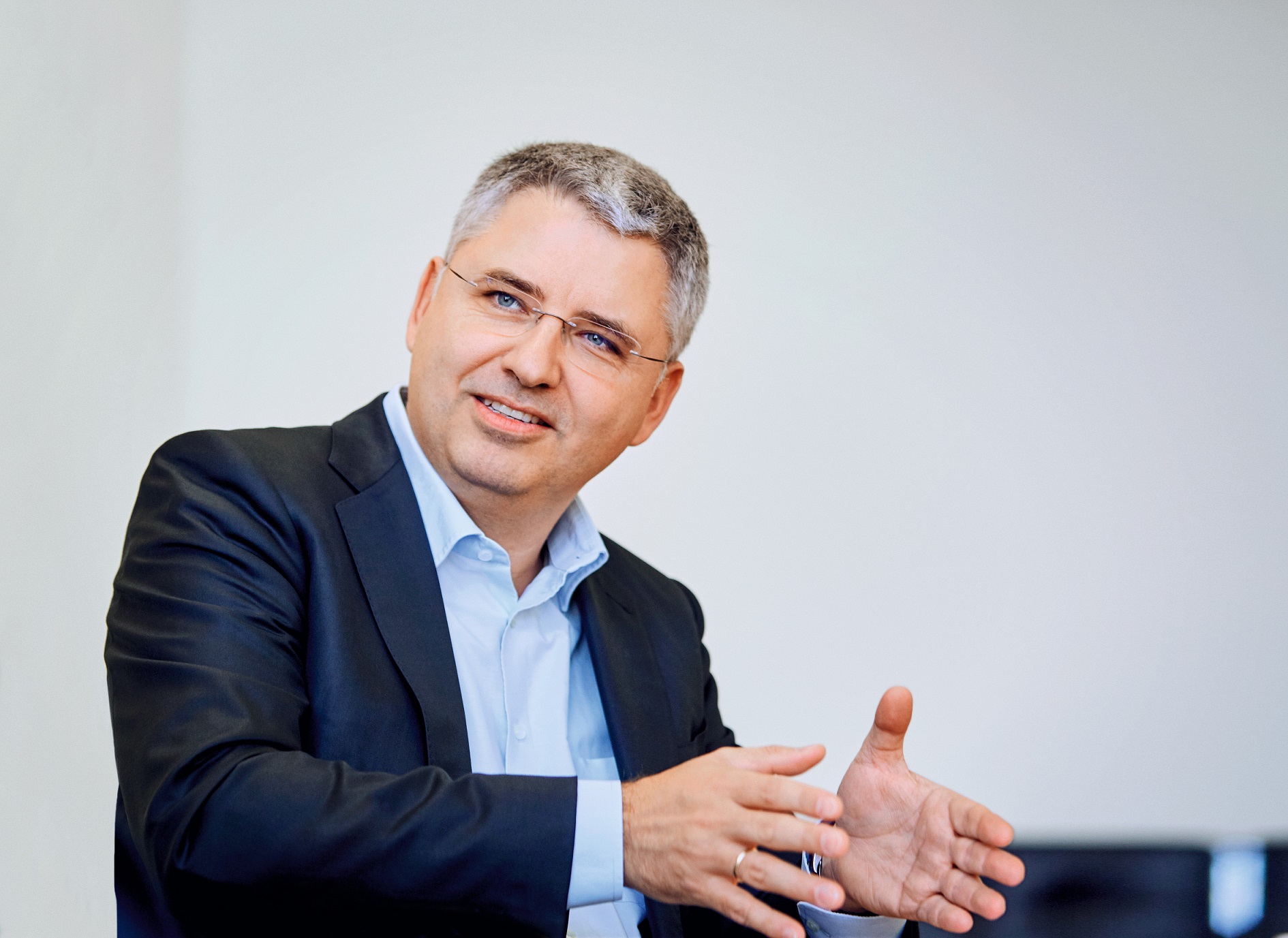“Innovation occurs at the interfaces”
The life sciences industry thrives on innovation. Roche CEO Severin Schwan and Endress+Hauser CEO Matthias Altendorf talk about what it takes to maintain a leadership position – and the role partnerships play.

Mr Schwan, regulatory requirements are an issue for your industry, political pressure on prices is another. Global competition is growing at the same time. What do you see as the biggest challenge?
Severin Schwan: The biggest challenge involves constantly developing new drugs and diagnostic processes. Roche is completely focused on innovation. If we don’t completely renew our portfolio within ten years, we can turn the lights out, because by that time the last patents will expire. Everything else stems from this one challenge. When we develop a very good drug, of course we have to manufacture it, distribute it at a fair price and succeed against competition. But the key is having that innovation in the first place.
Roche boasts one of the world’s largest corporate R & D budgets. How do you create and sustain an innovative environment?
Severin Schwan: Mainly through creative freedom. Creative people need space, they need air to breathe. If you constantly tell creative people how to do their jobs, put them inside little boxes and bury them with standard operational instructions, you will never create anything new.
Mr Altendorf, how does Endress+Hauser support the life sciences industry?
Matthias Altendorf: There are various aspects to that. We can help our customers operate efficient and stable processes. We can help them to properly fulfill regulatory requirements. And we can take activities off their hands that are not part of their core business. But most of all, our products, solutions and services, which are designed for process and lab automation, help to shorten the development cycle, from initial idea to market-ready product, and to manufacture these products efficiently.
For years, Roche has focused on the link between pharmaceuticals and diagnostics and thus personalized medicine. Is Endress+Hauser’s analytical strategy similarly forward-looking?
Matthias Altendorf: We’re talking about completely different fields, but a similar approach. Our customers want to capture not only quantitative, but qualitative parameters – in lab, pilot plant and production. This is why we strengthened the area of process analytical technology and moved into laboratory analytical technology with the acquisition of Analytik Jena. We want to help our customers to measure, monitor and validate the right parameters as early as the R & D phase and in their quality labs, so that they don’t have to re-evaluate the parameters when they transition to the next stage.
Severin Schwan: I can only confirm this. The development processes from research to the different phases of preclinical and clinical development are becoming more and more intertwined. It is a major advantage if as a partner you can support the processes beyond the value chain. If you can move seamlessly into further development, and then production, with the technologies that you began with, that translates into significant time savings.
What is the significance of having partnerships with providers such as Endress+Hauser?
Severin Schwan: We could not operate our business without partners; it’s as simple as that. If you approach cooperation from a long-term standpoint, if you work closely together along the entire value chain, if you understand each other’s needs, then a pure supplier relationship will evolve into a genuine partnership. Together you can create more value; that’s the great thing about a partnership!
What does Endress+Hauser do in order to be a good partner?
Matthias Altendorf: We try to stay close to our customers. We need a good understanding of their requirements and challenges. We have to know what impacts them and what challenges them. That way we can support them and help develop their business. We would not have recognized the significance of biotechnology if we hadn’t remained so close to our customers.
“We could not operate our business without partners. Together you can create more value; that’s the great thing about a partnership!”
Severin Schwan
CEO Roche

Roche is the leading provider of biotechnology-manufactured pharmaceuticals. How did biotechnology change your company and your business?
Severin Schwan: The basic prerequisites are independent of how you create a drug. The key is that you understand biology and recognize the starting points. Then you select the right technology in order to intervene in these biological processes in the body. In other words, the business model itself has not changed. But manufacturing a biotechnology substance requires a completely different process than chemically producing a tiny molecule.
Matthias Altendorf: The production process has changed dramatically. Biotechnology requires other parameters. As a supplier we have to be creative as well. Ten years ago, we never thought we would be able to measure glucose, which fuels the metabolism in a cell.
Severin Schwan: You offer that?
Matthias Altendorf: Using Raman spectroscopy, we can determine if the cells feel healthy, if they are growing and how well, if they have sufficient glucose and oxygen, if they are producing too much carbon dioxide…
Mr Schwan, how important is expertise for production at Roche?
Severin Schwan: Extremely important! Development usually occurs in cycles here. If you have command of a technology when it is new, that represents a competitive advantage. These technologies then become standard over the years. You can see that with small molecules, where there is a lot of outsourcing today.
In the field of biotechnology, the fact that Roche had an early command of the technology was a major advantage. The manufacture of first-generation antibodies has since become a standard process. For this reason, we have begun to outsource this process as well. We are now working with second- and third-generation, heavily modified antibodies, with which we can effectively utilize our knowledge to set the company apart. That’s why we’re keeping this process in-house for now, although the day will come when we will have to think about whether someone else can manage the process better and more efficiently.
Right next door, Roche has erected the tallest building in Switzerland. You have your office here in the venerable old administration building. What does that say about the corporate culture?
Severin Schwan: It has a lot to do with tradition. It signifies continuity and stability. That’s perhaps still more important to us than for other industries. We have extremely long product life cycles. We have to think long term. By the way, it was never our goal to create the highest building possible; that’s not part of our culture. But in order to house all of our employees in Basel at a single location, the only option was to go vertical. That’s why it was even more important that at least the management team keeps its feet on the ground! (Laughter.)
Matthias Altendorf: Architecture has an impact on people! The other is communication. It’s extremely important for creativity and collaboration to have people close to one another.
Severin Schwan: Absolutely. Innovation often occurs at interfaces where different functions come together. This also applies to relationships between companies, such as our partnership. It always goes back to the same issue: How do we remain a leader when it comes to innovation? We always have to have the best medication. No one wants to be treated with the second best!
What can Endress+Hauser learn from an innovation-driven industry such as life sciences?
Matthias Altendorf: The mechanisms, how creativity and innovation arise, are the same everywhere. You need the right people, and these people must feel comfortable. And you have to do everything to ensure that these people can be successful within a certain framework.
Severin Schwan: That applies not only to the business world by the way. Writers, musicians, painters and others are innovative exactly because they choose the path of creative freedom instead of following convention.
Matthias Altendorf: Interaction with the outside world is also important…
Severin Schwan: Artists inspire one another and also receive inspiration from the outside. It’s the same with us, whether it involves science or measurement engineering… Sharing information and experience is important!
Published 19.09.2019, last updated 06.06.2023.
Dive into the world of the process industry through new exciting stories every month with our «changes» newsletter!









